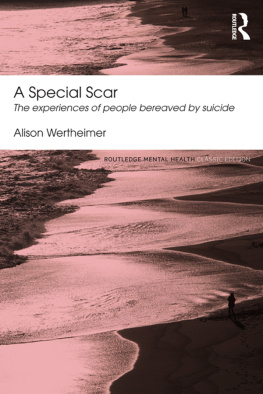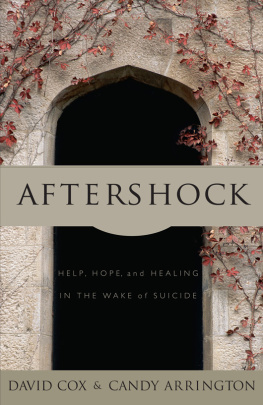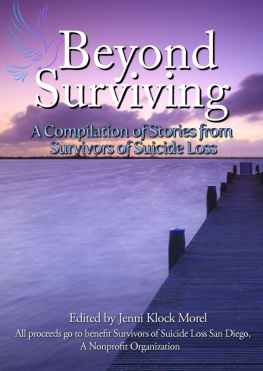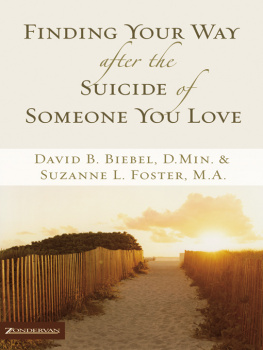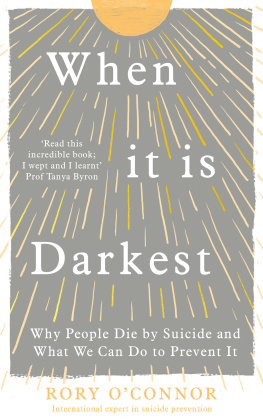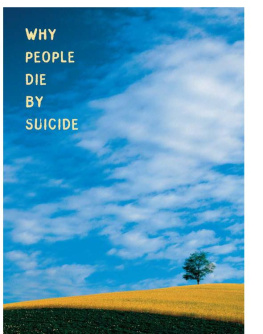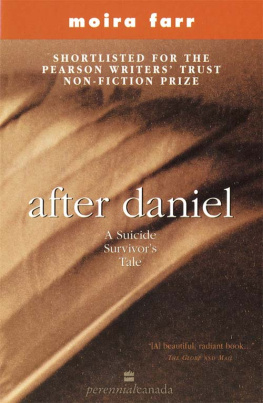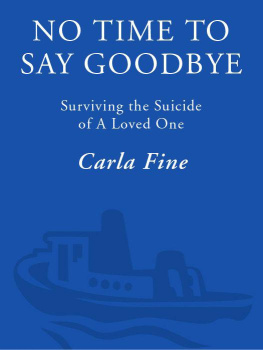A Special Scar
Every eighty-five minutes someone in the UK takes their own life and the suicide rate is currently the highest since 2004. Society often reacts with unease, fear and even disapproval but what happens to those bereaved by a self-inflicted death? The reasons leading someone to take their own life are complex, and the bereavement reactions of survivors of suicide can also be complex, including shame, guilt, sadness and the effects of trauma, stigma and social isolation.
It can be difficult for those personally affected by a suicide death to come to terms with their loss and seek help and support. A Special Scar looks in detail at the impact of suicide and offers practical help for survivors, relatives and friends of people who have taken their own life. Fifty bereaved people tell their stories, showing us that, by not hiding the truth from themselves and others they have been able to learn to live with the suicide, offering hope to others facing this traumatic loss.
This Classic Edition includes a brand-new introduction to the work and will be an invaluable resource for survivors of suicide as well as for all those who are in contact with them, including police and coroners officers, bereavement services, self-help organisations for survivors, mental health professionals, social workers, GPs, counsellors and therapists.
Alison Wertheimer has been a freelance writer, researcher and counsellor since 1987, after working in the voluntary sector for twenty years.
Routledge Mental Health Classic Editions
The Routledge Mental Health Classic Editions series celebrates Routledges commitment to excellence within the field of mental health. These books are recognized as timeless classics covering a range of important issues, and continue to be recommended as key reading for professionals and students in the area. With a new introduction that explores what has changed since the books were first published, and why these books are as relevant now as ever, the series presents key ideas to a new generation.
A Special Scar: The experiences of people bereaved by suicide (Classic Edition)
By Alison Wertheimer
An Introduction to the Therapeutic Frame (Classic Edition)
By Anne Gray
On Learning from the Patient (Classic Edition)
By Patrick Casement
Further Learning from the Patient (Classic Edition)
By Patrick Casement
A Special Scar
The experiences of people bereaved by suicide
Routledge Mental Health Classic Editions
Alison Wertheimer

This edition published 2014
by Routledge
2 Park Square, Milton Park, Abingdon, Oxon OX14 4RN
Simultaneously published in the USA and Canada
by Routledge
711 Third Avenue, NewYork, NY10017
Routledge is an imprint of the Taylor & Francis Group, an in forma business
2014 Alison Wertheimer
The right of Alison Wertheimer to be identified as author of this work has been asserted by her in accordance with sections 77 and 78 of the Copyright, Designs and Patents Act 1988.
All rights reserved. No part of this book may be reprinted or reproduced or utilised in any form or by any electronic, mechanical, or other means, now known or hereafter invented, including photocopying and recording, or in any information storage or retrieval system, without permission in writing from the publishers.
Trademark notice: Product or corporate names may be trademarks or registered trademarks, and are used only for identification and explanation without intent to infringe.
First edition published by Routledge 1991
Second edition published by Routledge 2001
British Library Cataloguing in Publication Data
A catalogue record for this book is available from the British Library
Library of Congress Cataloging in Publication Data
Wertheimer, Alison.
A special scar: the experiences of people bereaved by suicide / Alison Wertheimer. Routledge mental health classic edition.
pages cm
1. Suicide-Great Britain. 2. Bereavement. 3. Suicide victims-Family relationshipsGreat Britain. I. Title.
HV6548.G7W47 2013
362.2830941-dc23
2013015160
ISBN: 978-0-415-82467-5 (hbk)
ISBN: 978-0-415-82468-2 (pbk)
ISBN: 978-1-315-88445-5 (ebk)
For Anna Rosamunde
15 August 194226 February 1979
Clinical diagnoses are important but they do not help the patient. The crucial thing is the story. For it alone shows the human background and the human suffering.
Memories, Dreams, Reflections
C.G. Jung
A Special Scar was written in 1990 and subsequently revised in 2001, so writing this Foreword to the Classic Edition, I wondered has anything changed for people facing what is frequently a life-changing event: the bereavement following the suicide death of a family member, or friend or a colleague (or even media reports of suicide)? I suggest that my answer is yes and no as this Foreword will seek to explain.
The survivors personal stories remain at the heart of this book but are echoed in more recently published accounts of individual experiences (e.g. Begley and Quayle, 2007; Mental Health Matters / If U Care Share, 2010; Linn-Gust and Peters, 2010; and www.healthtalkonline). They frequently struggle with feelings of shame, guilt, sadness and the effects of trauma, stigma and social isolation, and they seek to understand why the death occurred. And eventually the survivor may be able to reach some understanding of the suicide death which makes sense to them and be able to move on with their own life.
However, if the aftermath of a self-inflicted death in many respects remains unchanged, research studies continue to refine and deepen our understandings of this particular bereavement. Just as there is no single reason which leads someone to end their life, so bereavement reactions too are multi-determined and the complex nature of this particular loss is a recurring motif in the suicide bereavement literature.
The findings of some recent studies suggest that bereavement after suicide is not necessarily more severe than other types of bereavement but certain features or themes are more prominent (Hawton and Simkin, 2003: 177). These themes include isolation, stigma, shame and guilt and a sense of rejection (Andriessen et al., 2007; Begley and Quayle, 2007; Hawton, 2007; Jordan, 2001) but also challenge previous assertions that suicide bereavement is always or necessarily worse than other losses or even the worst.
Research also continues to aid our understanding of survivors experiences of external events following a suicide, notably problems with the inquest procedures in the coroners court which can be a frequent source of distress for bereaved families (Harwood et al., 2002; Chapple et al., 2012). A study by Biddle (2003) also concluded that inquest procedures can exacerbate grieving and hinder the survivor reaching a meaningful and acceptable account of the death. Studies of the impact of media reporting have found this can be a further source of distress for some survivors (Chapple et al., 2013). As Chapple and her colleagues point out, media guidelines aim to prevent copycat suicides (e.g. by avoiding details of methods used), but bereaved peoples agendas were somewhat different; they were looking for accurate and sympathetic reporting, so inaccuracies, misquoting and speculation were, not surprisingly, upsetting.
Readers of this new edition might well expect a statistical update here, but although suicide figures for 2011 have recently been released, as the Samaritans have pointed out, there are significant challenges in collating and comparing these data, due to variations in the calculation methods (Samaritans, 2012a: 5). However, a recent report (Samaritans, 2012b) should be mentioned here as it sheds further light on a worrying statistical trend. The Samaritans study focused on suicides by disadvantaged men in their middle years where the rate for 4559-year-old men has increased significantly over recent years (and the rate for 3044-year-olds remains the highest for all groups). While their report drew attention to the many difficulties facing these men, following governments publication of the most recent suicide statistics, Samaritans added that It is high time that national suicide prevention strategies address suicide as a health and social inequality at both national and local level (Samaritans, 2013).
Next page
